
 |
Tea Clipper |
 |
| from TeaAntiques.com | ||
| Edition Seven |
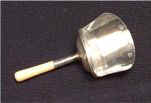 My
Featured Antique, is a delightful silver shovel caddy spoon, by Samuel
Pemberton, 1811. A lovely little item from the 'Regency' period, it has a pretty
bone handle and is a simple and elegant caddy spoon. For more details on this
and other fine antiques, please visit our web site
www.TeaAntiques.com.
My
Featured Antique, is a delightful silver shovel caddy spoon, by Samuel
Pemberton, 1811. A lovely little item from the 'Regency' period, it has a pretty
bone handle and is a simple and elegant caddy spoon. For more details on this
and other fine antiques, please visit our web site
www.TeaAntiques.com.
In England, at the beginning of the nineteenth century, the long reigning King George III was slowly going mad! His son, Prince George was made Prince Regent, and we refer to this period from 1800-1820 as the 'Regency' Period. On the death of George III in 1820, the Prince Regent became King George IV, and reigned for 10 years until his death in 1830. The period of King George IV's actual reign is also often considered, in antique terms, as being 'Regency' too.
As promised in the previous edition of the 'Tea Clipper', I have returned to the Geffrye museum, Kingsland Road, London, England. This time I am reviewing the 'Regency' room setting within the museum.
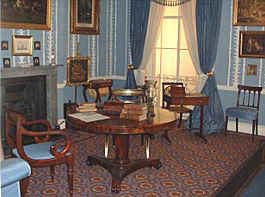 The room
is set in the period 1800-1830 and is a representation of how a drawing room, in
a London town house, might well have been decorated and furnished.
The room
is set in the period 1800-1830 and is a representation of how a drawing room, in
a London town house, might well have been decorated and furnished.
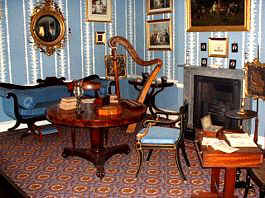 Unlike
the rigid formality of the eighteenth century, the Regency room shows a change
in taste towards a less formal domestic way of life. In such a room as this, the
whole family might have been occupied in such activities as reading, writing
letters, sketching, painting and the playing of music. The room would also have
been used as a place of entertaining guests, who might call at the house, maybe
for a musical gathering or just tea and gossip! Such activities are demonstrated
here by the inclusion of a comfortable upholstered sofa, light and easily
moveable tables and chairs, bookcases, writing table, card table and a very fine
Harp.
Unlike
the rigid formality of the eighteenth century, the Regency room shows a change
in taste towards a less formal domestic way of life. In such a room as this, the
whole family might have been occupied in such activities as reading, writing
letters, sketching, painting and the playing of music. The room would also have
been used as a place of entertaining guests, who might call at the house, maybe
for a musical gathering or just tea and gossip! Such activities are demonstrated
here by the inclusion of a comfortable upholstered sofa, light and easily
moveable tables and chairs, bookcases, writing table, card table and a very fine
Harp.
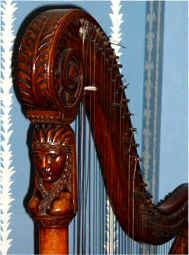 Furniture
of the Regency period derived decorative features from baroque, rococo, French
Empire and Egyptian patterns. Indeed, the harp has a most beautifully carved
Egyptian figure head forming part of a very elaborate beech and satinwood frame.
This delightful harp was made by Gregor Deis of Munic c1810.
Furniture
of the Regency period derived decorative features from baroque, rococo, French
Empire and Egyptian patterns. Indeed, the harp has a most beautifully carved
Egyptian figure head forming part of a very elaborate beech and satinwood frame.
This delightful harp was made by Gregor Deis of Munic c1810.
The use of wallpapers was now becoming more affordable and widespread in middle class homes. This room, shows a pretty blue and white foliate striped paper, (wallpaper of this period is well know for the Regency stripe, so often copied today).
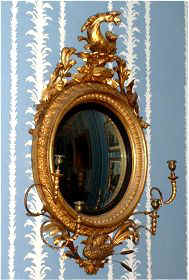 The
rather gay flamboyancy of the period, is expressed in its opulent furniture and
decoration. Take for example this exquisite gilt framed wall mirror, the whole
thing alive and dancing! The use of carved moving animals and birds, foliage and
twisting candle brackets. Can you imagine this lit with candles on a dark
evening, fire burning in the hearth and guests laughing and joking playing at
cards?
The
rather gay flamboyancy of the period, is expressed in its opulent furniture and
decoration. Take for example this exquisite gilt framed wall mirror, the whole
thing alive and dancing! The use of carved moving animals and birds, foliage and
twisting candle brackets. Can you imagine this lit with candles on a dark
evening, fire burning in the hearth and guests laughing and joking playing at
cards?
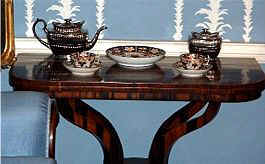 The room
would of course also been used for the taking of tea, in the afternoon or after
dinner. Standing against the wall of this room is a card table veneered in
Calamander or 'Zebra' wood, with brass mounts and inlays, on which stand some
tea related items. These include a silver Lustre teapot and sugar box, teacups
and saucer and a cake plate with oriental type decoration.
The room
would of course also been used for the taking of tea, in the afternoon or after
dinner. Standing against the wall of this room is a card table veneered in
Calamander or 'Zebra' wood, with brass mounts and inlays, on which stand some
tea related items. These include a silver Lustre teapot and sugar box, teacups
and saucer and a cake plate with oriental type decoration.
Another very useful item of furniture within the room, is a central table, mahogany veneered on a pedestal base, c1830. This type of table was very fashionable in this period. Unlike the arrangement of furniture in the eighteenth century around the edge of the room, furniture was now starting to occupy the whole room, making them feel much more comfortable.
In a later edition of the Tea Clipper, I will return again to the Geffrye museum to look at another period of social history.
For details of the Geffrye museums opening times, please refer to my my previous newsletter, or view their web site: www.geffrye-museum.org.uk.
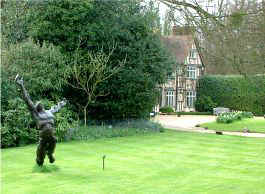 My tea shop
recommendation for May is not so much a tea shop, but a restaurant which serves
customers on the terrace of this country house in East Sussex.
My tea shop
recommendation for May is not so much a tea shop, but a restaurant which serves
customers on the terrace of this country house in East Sussex.
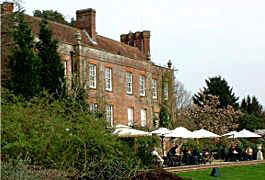 Pashley
Manor is to be found in Ticehurst, Nr Wadhurst, East Sussex, England. The house
(not open to the public) is steeped in history, Anne Boleyn, second wife of
Henry VIII, spent some of her childhood here. The Tudor house was built in 1543
by Sir Thomas May. This Tudor house, had a Georgian Facade added in 1720 and it
is on the terrace in front of this part of the house, that people can sit and
enjoy refreshments, surrounded by the beauty and tranquillity of the gardens.
Pashley
Manor is to be found in Ticehurst, Nr Wadhurst, East Sussex, England. The house
(not open to the public) is steeped in history, Anne Boleyn, second wife of
Henry VIII, spent some of her childhood here. The Tudor house was built in 1543
by Sir Thomas May. This Tudor house, had a Georgian Facade added in 1720 and it
is on the terrace in front of this part of the house, that people can sit and
enjoy refreshments, surrounded by the beauty and tranquillity of the gardens.
The restaurant prides itself on its food. Items on offer include home-made soups, ploughman's lunches as well as afternoon teas, with home made scones and cakes. After, or before tea, a gentle stroll round the beautifully kept gardens can be enjoyed. As well as the fine gardens, there are exhibitions of sculptures by leading British sculptors, set both around the gardens and in the Great Hall of the house.
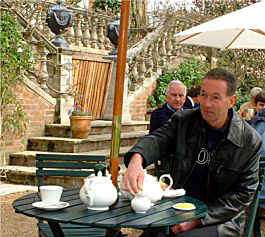
A very relaxing way to spend an afternoon.
Please note that there is an admission charge for the gardens, including the restaurant. The gardens and restaurant are open from April to the end of September.
For further details:
Telephone: 01580 200888
Fax: 01580 200102
Web Site: www.pashleymanorgardens.com
To review past newsletters, just follow this link:
Past newsletters.
To subscribe to this free newsletter -
Click here